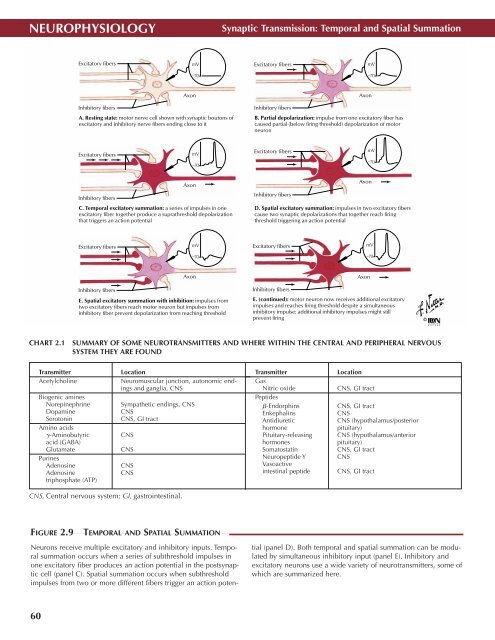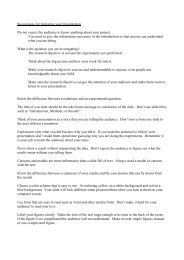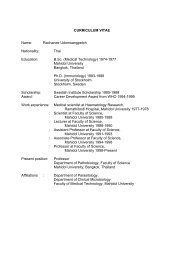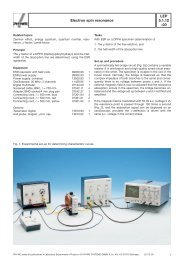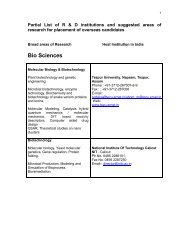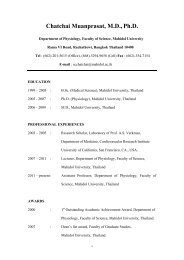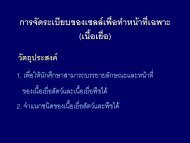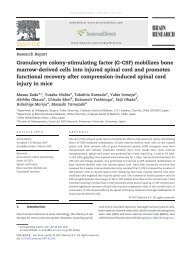Create successful ePaper yourself
Turn your PDF publications into a flip-book with our unique Google optimized e-Paper software.
NEUROPHYSIOLOGY<br />
Synaptic Transmission: Temporal and Spatial Summation<br />
Temporal and Spatial Summation<br />
of Excitation and Inhibition<br />
Excitatory fibers<br />
mV<br />
Excitatory fibers<br />
mV<br />
–70<br />
–70<br />
Axon<br />
Axon<br />
Inhibitory fibers<br />
A. Resting state: motor nerve cell shown with synaptic boutons of<br />
excitatory and inhibitory nerve fibers ending close to it<br />
Inhibitory fibers<br />
B. Partial depolarization: impulse from one excitatory fiber has<br />
caused partial (below firing threshold) depolarization of motor<br />
neuron<br />
Excitatory fibers<br />
mV<br />
–70<br />
Excitatory fibers<br />
mV<br />
–70<br />
Inhibitory fibers<br />
Axon<br />
C. Temporal excitatory summation: a series of impulses in one<br />
excitatory fiber together produce a suprathreshold depolarization<br />
that triggers an action potential<br />
Inhibitory fibers<br />
Axon<br />
D. Spatial excitatory summation: impulses in two excitatory fibers<br />
cause two synaptic depolarizations that together reach firing<br />
threshold triggering an action potential<br />
Excitatory fibers<br />
mV<br />
Excitatory fibers<br />
mV<br />
–70<br />
–70<br />
Axon<br />
Axon<br />
Inhibitory fibers<br />
E. Spatial excitatory summation with inhibition: impulses from<br />
two excitatory fibers reach motor neuron but impulses from<br />
inhibitory fiber prevent depolarization from reaching threshold<br />
Inhibitory fibers<br />
E. (continued): motor neuron now receives additional excitatory<br />
impulses and reaches firing threshold despite a simultaneous<br />
inhibitory impulse; additional inhibitory impulses might still<br />
prevent firing<br />
©<br />
CHART 2.1<br />
SUMMARY OF SOME NEUROTRANSMITTERS AND WHERE WITHIN THE CENTRAL AND PERIPHERAL NERVOUS<br />
SYSTEM THEY ARE FOUND<br />
Transmitter<br />
Acetylcholine<br />
Biogenic amines<br />
Norepinephrine<br />
Dopamine<br />
Serotonin<br />
Amino acids<br />
-Aminobutyric<br />
acid (GABA)<br />
Glutamate<br />
Purines<br />
Adenosine<br />
Adenosine<br />
triphosphate (ATP)<br />
Location<br />
<strong>Neuro</strong>muscular junction, autonomic endings<br />
and ganglia, CNS<br />
Sympathetic endings, CNS<br />
CNS<br />
CNS, GI tract<br />
CNS<br />
CNS<br />
CNS<br />
CNS<br />
Transmitter<br />
Gas<br />
Nitric oxide<br />
Peptides<br />
-Endorphins<br />
Enkephalins<br />
Antidiuretic<br />
hormone<br />
Pituitary-releasing<br />
hormones<br />
Somatostatin<br />
<strong>Neuro</strong>peptide Y<br />
Vasoactive<br />
intestinal peptide<br />
Location<br />
CNS, GI tract<br />
CNS, GI tract<br />
CNS<br />
CNS (hypothalamus/posterior<br />
pituitary)<br />
CNS (hypothalamus/anterior<br />
pituitary)<br />
CNS, GI tract<br />
CNS<br />
CNS, GI tract<br />
CNS, Central nervous system; GI, gastrointestinal.<br />
FIGURE 2.9<br />
TEMPORAL AND SPATIAL SUMMATION •<br />
<strong>Neuro</strong>ns receive multiple excitatory and inhibitory inputs. Temporal<br />
summation occurs when a series of subthreshold impulses in<br />
one excitatory fiber produces an action potential in the postsynaptic<br />
cell (panel C). Spatial summation occurs when subthreshold<br />
impulses from two or more different fibers trigger an action potential<br />
(panel D). Both temporal and spatial summation can be modulated<br />
by simultaneous inhibitory input (panel E). Inhibitory and<br />
excitatory neurons use a wide variety of neurotransmitters, some of<br />
which are summarized here.<br />
60


